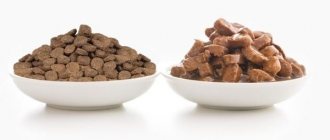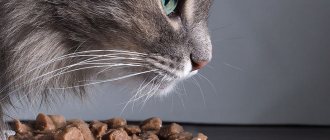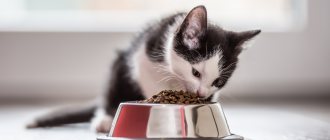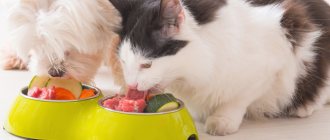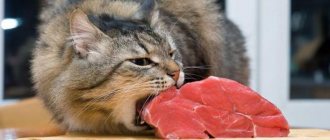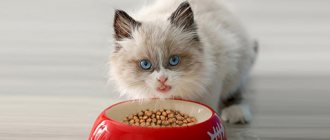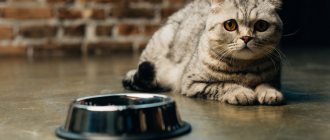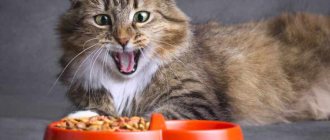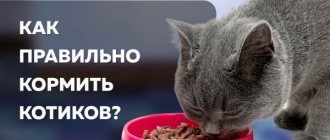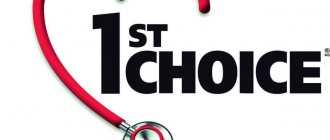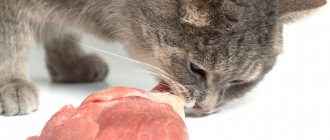This is a common question that arises among cat and dog owners at the same time.
The short answer is yes, a cat can eat a small amount of dog food and there will be no toxic or long-term effects.
However, the more detailed answer concerns the species differences between our feline friends and dogs. While a piece of stolen dog food won't harm cats, it certainly won't help them achieve their best health.
Here's what you need to know about cat nutrition and why you shouldn't give your cats dog food in the long run.
Cats and dogs have different nutritional needs
Although both dogs and cats share our hearts and homes, over time nature has evolved them into very different animals with very different nutritional needs.
Cats are obligate carnivores, meaning that they require a diet consisting of meat-based proteins and animal fats in order for all of their body systems to function properly.
On the other hand, dogs are actually omnivores. An omnivore has a more flexible diet and can easily eat both meat and vegetables. Dog food does not meet the specific nutritional needs of cats.
How to keep your cat safe
Cats should not be given dog food.
But if both animals live in the house, it is difficult to keep track of how often the cat eats from the other pet's bowl. To keep your animal safe, you need to follow a number of recommendations:
- It is recommended to feed the cat and dog in different rooms, but at the same time. The cat will be busy with its food and will not encroach on the dog's bowl. After feeding the animals, food must be removed immediately.
- Feed should be stored in an inaccessible place where animals cannot reach it. The smell of dog food will attract your cat, and if it finds a bag of food, it may chew through it and eat it.
- To feed a large dog, it is recommended to use special stands for the bowl so that it is located on a hill where the cat cannot reach.
If a cat has often eaten dog food, it may get used to it and refuse other food. In this case, you will have to wean your pet off the wrong diet.
Also watch the video: Can a cat get dog food, but can a kitten get cat food?
Differences between cat food and dog food
Here are just a few key differences in dog and cat food formulations.
Taste
Cats perceive taste differently than dogs. Cats, unlike dogs, are unable to taste sweetness, and even the number of taste buds differs between the two species.
Cats have a measly 470 taste buds, while dogs have 1,700—for reference, humans have over 9,000.
Cat food is specially formulated to be highly palatable to entice our sometimes picky (and taste bud-deprived) feline friends to eat.
*Note: Cats generally don't even want to eat dog food, as they tend to find it unappetizing. Dogs, however, love tasty food that is high in protein.
Protein
Being strict carnivores by nature, cats require food with a much higher protein content than dog food.
Rare brands and types of dog food do contain higher levels of protein, but in general, even these specialized dog foods do not achieve the high levels of protein needed to keep cats healthy.
Most dog foods contain 18-26% protein in the diet. For cats, however, I generally recommend aiming for at least 30-34% protein in the diet, with the addition of canned cat food containing 40-50% protein.
Taurine
Cats (and humans) are among the few mammals that are unable to produce taurine, so they must obtain this important element from their diet.
Cats lacking taurine in their diet may have:
- Weakened heart (dilated cardiomyopathy)
- Loss of vision
- Digestive problems
All commercially available cat foods today contain taurine; however, it is rarely added to dog food.
Arachidonic acid
Arachidonic acid is a fatty acid that cats cannot produce either - it must be ingested.
Cats suffering from low arachidonic acid levels have nonspecific signs of the disease, such as:
- Abnormal liver/kidney readings
- Sometimes increased skin problems
Dogs can produce this fatty acid themselves and therefore dog food is rarely supplemented with it.
Vitamin A
Vitamin A is another dietary element that cats cannot synthesize on their own and must supplement their diet.
Although dog foods often contain vitamin A supplements, these foods will never contain large enough amounts to provide optimal nutrition for cats.
Cats suffering from vitamin A deficiency will have the following symptoms:
- Low quality wool
- Muscle weakness and deterioration
- Possible night blindness
Niacin
It is important that your cat's diet also contains niacin, since cats cannot make it themselves.
Animal tissue is the most common source of niacin in cat food; but the plants have low levels of niacin.
But food containing lower levels of animal tissue and higher content of plant tissues, such as grains, may not provide cats with the proper levels of niacin they need.
Animal protein
The animal protein content in ready-made industrial diets for dogs is lower than for cats. Over several tens of thousands of years of living next to humans, dogs have adapted to assimilate small amounts of plant food and grain, while cats were and remain obligate predators, adapted to eat only meat. Therefore, if there is not enough animal protein in the food, this affects the functioning of the pet’s muscles and internal organs, since protein is the main building material for all cells of the body.
The quality of the feed is also very important
In the pet food industry, life stages are divided into three main groups:
- Height
- Service
- All stages of life
Not only do cats have certain general protein, vitamin and nutrient requirements, but these also change throughout their life cycle.
Fast-growing kittens require more nutrients and energy sources, while older, healthy cats need more protein to support their muscles as they age.
Dog food with lower percentages of protein and other nutrients cannot support a cat over the long term at any stage of its life.
Why does a cat eat cat food?
There are several reasons for this:
- Frequent consumption of dog food can indicate that your cat has a number of health problems, both acute and chronic.
- The animal's attempts to compensate for the insufficient amount of zinc or tocopherol.
- The cat does not like the taste of its own food.
Owner's actions. To understand what exactly motivates a cat that eats from a dog's bowl, you need to watch it. If the situation does not repeat itself often, perhaps the cat is simply being curious. If an animal constantly refuses its food in favor of dog food, it is necessary to conduct a thorough diagnosis of its health condition. Perhaps the furry purr has some health problems.
Does a cat need fat?
Owners are wary of fat in their cat’s diet, especially if the cat is prone to obesity. But in reality, fat alone will not make a predator fat, just as greens do not make herbivores green. An animal gains excess weight not because of specific macronutrients, but because the total caloric content of the diet is exceeded. If a high-fat food contains a minimum of carbohydrates and is dosed correctly, the cat will be in excellent shape.
Domestic dogs have partly adapted to extract energy from carbohydrates, so dog foods sometimes contain less animal fat and more grains. By consuming such a product regularly, cats will receive less of the essential arachidonic acid, which affects the health of the reproductive, gastrointestinal and other systems. In addition, vitamin A (retinol) is fat-soluble, and if it is not fully absorbed by the cat’s body, it will lead to decreased vision, hair loss, and in the case of kittens, growth retardation.
Consequences
If cats are regularly fed dog food, they may develop health problems:
- With a lack of protein, muscle mass is lost and replaced by fat.
- Excess carbohydrates overload the pancreas, leading to excess weight gain.
- A lack of taurine affects eye health, retinal atrophy occurs, vision decreases, and digestion is upset. Over time, the heart muscle weakens and cardiomyopathy develops.
- With a lack of arginine, symptoms of ammonia poisoning appear: lethargy, nausea, drooling, convulsions.
- A deficiency of unsaturated fatty acids provokes skin problems: the structure of the skin is disrupted, dandruff appears, the coat loses its shine, and falls out. The animal often catches colds and suffers from indigestion.
- With hypervitaminosis D, calcium metabolism is disrupted and it is deposited in soft tissues.
- Excess ascorbic acid increases the acidity of urine and precipitates in the form of crystals.
- Excess retinol affects the musculoskeletal system and joint mobility.
- Tocopherol deficiency leads to decreased immunity and reproductive functions.
- Against the background of a lack of nicotinic acid (PP), metabolism and digestion are disrupted, and dermatitis develops.
- With excess calcium, bone tissue grows and kidney problems begin.
- Excess magnesium provokes urolithiasis.
The composition of dog food is not suitable for cats, so pets are given food at different times, each is given a place, and no food is left out. If the cat continues to reach for the dog bowl, try changing the brand of food. Accidentally eating pellets will not affect the cat’s health; intentional feeding involves a trip to the veterinary clinic.
Composition of dry and wet
As mentioned above, cats consume fish, so fish, salts and salted meat are added to dry cat food. The amount of protein in them is quite high, and there is practically no fat . Canned food contains a small amount of vegetables, as well as a thick broth.
Dry dog food contains poultry, rabbit and beef. Protein and fat are in approximately equal proportions. Canned food is made from animal meat, sometimes crackers or pieces of meat jelly are added.
How to stop eating cat food
What should you do if your four-legged friend not only eats the cat’s food, but also constantly watches over him and has no intention of weaning himself off?
It is worth being patient and systematically weaning yourself from this bad habit. To do this, you need to take into account the following recommendations:
- It is better to feed your pets at different times. It is better to feed the dog first. Then fill the cat’s bowl and distract the second pet with a game or take it for a walk so that the cat eats in peace;
- In order not to be constantly “on guard”, you can choose a place for the cat’s bowl that the dog simply cannot reach. This could be a window sill, an open cabinet shelf, or any other place. It is better if it is on a hill. It won't be difficult for a cat to get to it;
- Do not leave food in your mustachioed pet's plate overnight. This will benefit both: one will not eat food that is harmful to him, and the second will have an excellent appetite in the morning;
- You should not use pieces of dry food for cats as treats during education and training. It is better to buy special treats in the store or make them yourself. It will be much healthier;
- The upbringing of your pet will greatly help in this matter. If he is familiar with the basic commands, the owner will only need to repeat the command “fu!” several times. and the weaning process will be over.
Thus, it is worth weaning your dog off cat food patiently and systematically. It must be remembered that such an unadapted diet can cause the most severe harm to the body of an elderly animal, puppy or pregnant bitch.
Photo: thehappypuppysite.com
Can dogs be given cat food: how can it be dangerous?
It is quite difficult to answer this question unequivocally, since the body of animals reacts differently. However, some veterinarians argue that for representatives of small breeds of dogs such food can be truly dangerous.
Cat food contains a lot of protein. This component in large quantities is very dangerous for dogs, especially puppies. Protein negatively affects the functioning of the liver and also impairs the functioning of the digestive system. This component leads to the appearance of diseases associated with the performance of the heart or kidneys. In some cases, allergic reactions appear in the form of redness on the pet’s body. Other signs of excess protein include:
- strong mobility;
- nervousness;
- constipation.
Obesity is one of the consequences of regular consumption of cat food.
Also, cat food contains a lot of fat, which causes obesity and pancreatitis in dogs.
Food for dogs and cats contains different vitamins, which also negatively affects the functioning of organs. For example, cat food contains virtually no magnesium, which dogs need.
Additional Information. If you often feed dogs cat treats, the animals will develop gastritis or even ulcers. These diseases can occur due to the fact that cat food contains taurine in large quantities.
Why owners choose dog food to feed cats
Dog food of the same brand as cat food is often cheaper. Most stores offer regular promotions and discounts on dog food. But the money saved will have to be spent on veterinarian services soon.
Dry dog food is usually purchased in large packs and is always on hand. But you can also buy cat food in large packages of 10-15 kg, which will last for a long time.
If the owner sees that the cat eats dog food with pleasure, there may be a feeling that the cat prefers this particular type of food. Therefore, the owners decide that there is nothing wrong with such feeding.
How to stop a cat from eating dog food
It is almost impossible to prevent dog food from being eaten when tempted. Of course, you can try, but the only thing the thief will react to in this case is an imaginary threat. For example, sound traps made from cans and nuts or cereals. You can wait for your pet to approach the dog bowl and scare him with noise each time, but we do not recommend doing this.
Firstly, for such weaning you will have to be consistent and patient. The cat will try again and again to get to the dog food. You will need to stop all attempts. If an animal manages to steal someone else’s food at least once, the progress can be considered zero. Cats can be persistent, so think three times before declaring “war.”
If you don’t want to make traps yourself, you can purchase a ready-made option - Fisher discs
Secondly, you will have to leave the traps so that they are triggered when you are not at home or you are sleeping. Otherwise, the cat will only steal at night and in your absence. If she realizes that there is no one to punish her, she will take advantage of it. Theoretically, of course, you can organize such traps: fasten them with threads, for example, so that when approaching the bowl, a plastic glass of water falls on the cat. But such designs have many disadvantages. The cat may eat the thread and get injured. In addition, this way you can scare the dog.
The main disadvantage is the possibility of psychological disorders. Noise, water and other punishments can cause your pet to become nervous. Animals with a weak heart are more likely to develop complications. To correctly wean a cat from stealing in this way, you need to have great patience and take into account all the nuances. Otherwise, your pet may develop phobias. For example, a pet may refuse not only dog food, but also its own dry food, deciding that the whole problem lies in the granules. For this reason, we suggest turning to other measures. It is advisable to combine several methods to ensure success.
Elimination of access to the food bag
The cat can steal food directly from the bag. Owners are not always able to immediately notice the loss, especially if a large dog lives in the house, for which they buy large packages. To prevent theft, the bag should be put in the pantry, on the balcony or in another place protected from attacks by the pet.
Containers also help solve the problem of dry food spoilage
If free space is limited and there is no way to hide the packaging, you can purchase special plastic containers. Clothespins and other devices will not help preserve food, since the cat can easily cope with such structures. In extreme cases, it can chew a hole in the bag. A container is a different matter: its walls cannot be bitten through, and the tight lid cannot be removed with the help of paws.
Purchasing bowls on a high stand
Bowls on a stand help eliminate access to dry food. The method only works in the case of large dogs: small pets will no longer reach the dishes, which will create a lot of inconvenience.
The stand is adjustable, allowing you to choose the optimal height
There should be no other furniture or large objects near the bowls, even if there is a stand. They can create a kind of platform for the cat. This method does not always help, since flexible pets sometimes still manage to get into the bowl, so owners of overly bold pets need to combine several methods.
Separate feeding
The main way to wean yourself from theft. If you feed animals nearby and at different times, you yourself encourage a bad habit, because the cat also wants to try. In addition, instincts can come into play: the mustachioed pet is outraged that he, the leader, is not fed, while the dog, which occupies a lower position, is given food. This is a kind of provocation and a reason for conflict.
Animals prone to theft should be fed simultaneously, but in different rooms. It is advisable to close the doors to the rooms to reduce temptation. A cat, captivated by the process, is unlikely to want to fight the dog for its food. If your pet starts to get nervous and demands to be allowed into someone else’s bowl, just remove the food after 15 minutes. Next time, a hungry cat will probably prefer to eat without coaxing.
Eliminating free access to food for the dog
Dogs tend to eat large meals in a limited amount of time. Free access to food is not natural for them, so it is better to feed your pet on a schedule. This will not only help wean the cat from stealing, but will also maintain the dog’s health: due to the ability to eat at any time, the latter may become obese.
To prevent problems with appetite, you should limit your time. If the dog has not eaten the entire portion within 10–15 minutes, remove the rest. Next time, reduce the amount of food a little: this behavior indicates that there is too much food. In the future, this may cause poor appetite due to weakening instincts.
General recommendations for feeding cats with industrial food
All industrial feeds have advantages and disadvantages. The first usually outweighs the second due to lack of time from the owners. An alternative to food is a natural diet, that is, regularly preparing food for your pet.
Industrial cat food is divided into classes and types:
- Economy, premium (everyday), super-premium, holistic.
- Wet, semi-moist, dry food.
Super-premium and higher class cat food contains all the important nutrients, vitamins and microelements. In this case, the owner can feed the cat dry food, alternating with semi-moist or wet food (of the same brand and line).
Economy and premium classes are not fully fortified and may contain preservatives. At the same time, premium food is considered everyday food, that is, suitable for regular feeding of healthy animals. Economy class is a dangerous line, produced with the expectation of illiterate owners. Vivid advertising and a relatively attractive price play a significant role. Trying to do the best, owners literally sacrifice the health of their pets... although if the owner reads the ingredients of the product, then the risk is quite conscious.
The modern range of food allows you to choose a balanced diet for any, even the most picky pet. At the very least, the cat will definitely not refuse to eat wet food or pates. Some difficulties may arise with the selection of dry food, since it is not so fragrant.
Is it possible for dogs?
Everything is individual and situational. Cat food contains a lot of protein, which can slow down your dog's digestion process. But if your pet is active, then his body needs just this amount of protein. Another question is whether the dog’s body can digest fish and salty foods?
REFERENCE! We often hear that if a dog eats something, then its body needs it. Let's remember that dogs eat out of garbage cans out of curiosity. Like all animals, they explore the world around them and try something new. This factor is inherent in all living beings; it can solve the problem of lack of food in difficult times.
In other words, if a dog, during a period of hunger, tasted food from a trash bin and concluded that it helped it survive , this information will be passed on to future generations, continuing the family line and increasing the chances of interspecific competition.
If your pet has consumed cat food once , it may cause minor changes in digestion, but will not lead to serious problems.
In cases of systematic use , the gastrointestinal tract will sooner or later adapt to digesting these products.
But this does not always happen, keep an eye on your pet’s feces and condition ; if you notice that his behavior and well-being have changed for the worse, you need to stop feeding him cat food and take him to a veterinary clinic.
If there is no other
If you are standing in front of a shelf where only cat food remains, then choose based on the following factors:
- Lack of cheap ingredients (soy, flour, vegetable by-products).
- Look at the price. It is better to take a small package of premium quality so as not to risk your pet’s health.
- They also produce meat food and various assorted food for cats. Choose food without fish or salt .
- Pay attention to the amount of protein , it should not exceed 15-20 grams per 100 grams of dry product.
- If it contains taurine , such food can be given, but in smaller quantities, since taurine is produced by the dog’s body and has a feedback mechanism with histamine. The more taurine, the less histamine. This means that in the event of an allergy, external signs (scabies, rash, hair loss) will not appear, but the internal ones will occur in full. This is dangerous because it can lead a latent disease to an advanced stage, which will be more difficult to cure.
Economy or premium?
These two types of food are radically different:
- Economy class food is food for every day. They have a cheap price due to the low quality of the components of the composition. Instead of a cereal or corn base, soy, starch, and plant by-products can be used here. The meat part takes up no more than 20%.
- Premium food is a treat that rewards animals for completing tasks, during training, or simply makes pets happy from time to time. The price of such feeds is quite high, the feed components are high-quality and expensive, the share of meat components is 70-80%.

